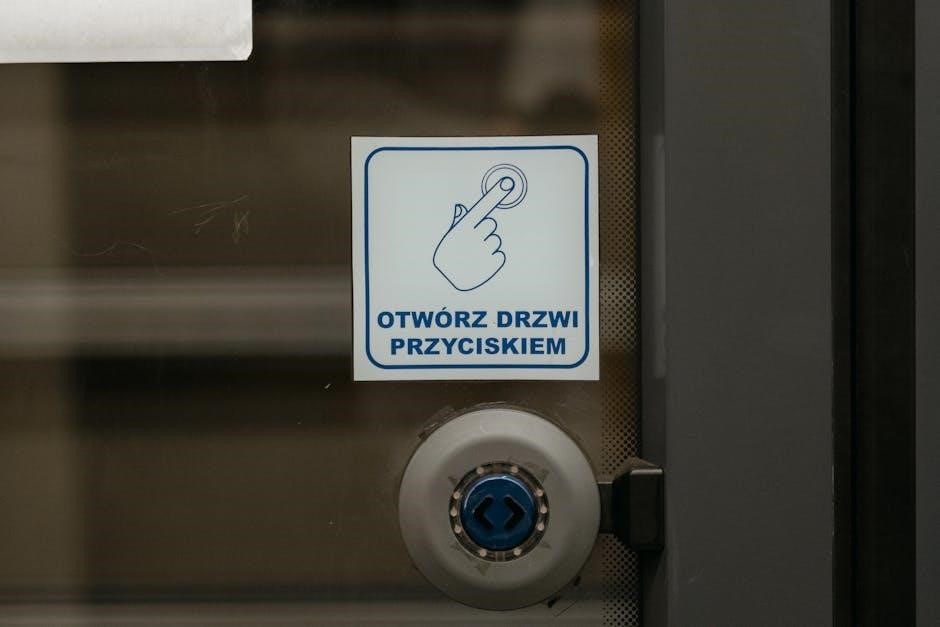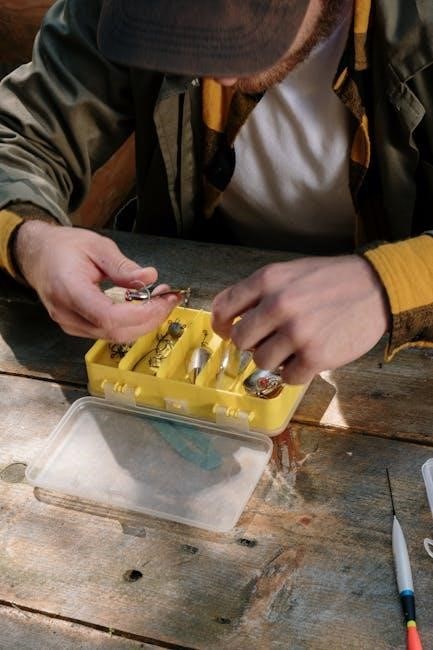The Fisher 667 actuator is a durable, high-performance diaphragm actuator designed for precise control in industrial applications․ It offers reliability, ease of installation, and versatile configurations, supported by a comprehensive instruction manual for optimal setup and maintenance․
1․1 Overview of the Fisher 667 Diaphragm Actuator
The Fisher 667 diaphragm actuator is a high-performance, durable device designed for precise control in industrial applications․ Available in sizes 30/30i, 80, and 100, it offers flexible configurations to meet various operational needs․ The actuator is known for its reliability and ease of integration into existing systems․ Its design ensures efficient operation, making it a popular choice for industries requiring consistent and accurate control․ The comprehensive instruction manual provides detailed guidance for installation, adjustment, and maintenance, ensuring optimal performance and longevity․
1․2 Importance of the Instruction Manual
The instruction manual is essential for the proper installation, operation, and maintenance of the Fisher 667 actuator․ It provides detailed guidelines, diagrams, and specifications to ensure optimal performance and safety․ The manual includes troubleshooting tips, parts ordering information, and configuration instructions, making it a critical resource for users․ Adhering to the manual’s recommendations helps prevent malfunctions, extends the actuator’s lifespan, and ensures compliance with safety standards․ Referencing the manual is crucial for both novice and experienced users to maximize the actuator’s efficiency and reliability in industrial applications․

Installation Guidelines
Proper installation ensures optimal performance and safety․ Follow the manual for step-by-step instructions, pre-installation checks, and model-specific requirements to avoid malfunctions and ensure reliability․
2․1 Step-by-Step Installation Process
The Fisher 667 actuator installation begins with unpacking and verifying components․ Mount the actuator securely, ensuring alignment with the valve․ Connect pneumatic or electrical controls as specified․ Perform a thorough pre-operation test to ensure functionality․ Refer to the manual for torque specifications and wiring diagrams․ Proper installation ensures smooth operation and longevity of the actuator․ Always follow safety guidelines to prevent damage or injury․
2․2 Pre-Installation Checks and Preparations
Before installing the Fisher 667 actuator, ensure all components are undamaged and compatible with the system․ Verify the actuator model matches the valve and application requirements․ Check for proper pneumatic or electrical connections and ensure the control signal is calibrated․ Review the instruction manual for specific torque values and installation tools․ Clean the area to prevent contamination and ensure all safety protocols are in place․ Proper preparation minimizes installation errors and ensures system reliability․

Adjustment and Configuration
Calibrate the actuator according to specified parameters and configure settings to meet system requirements․ Adjustments ensure precise control and optimal performance, following manual guidelines carefully․
3․1 Calibrating the Actuator
Calibration ensures precise actuator performance․ Start by setting the zero point using the manual’s instructions․ Adjust the span to match system requirements․ Use the Fisher 667 manual’s calibration procedures to ensure accuracy․ Perform a full stroke test to verify proper operation․ Re-calibrate after installation to account for system dynamics․ Always use approved tools and follow safety guidelines during calibration․ Regular re-calibration is recommended to maintain optimal performance and ensure reliable operation over time․
3․2 Configuring Actuator Settings for Optimal Performance
Configure the actuator settings to match your system’s specific requirements․ Access the configuration menu via the control interface and adjust parameters such as response time, stroke limits, and feedback sensitivity․ Test the actuator’s responsiveness under various conditions to ensure smooth operation․ Fine-tune settings incrementally, monitoring performance closely․ Refer to the Fisher 667 manual for detailed configuration options․ Proper setup ensures reliability, efficiency, and precise control, minimizing wear and tear while maximizing system performance over time․

Maintenance and Servicing
Regular maintenance ensures optimal performance and longevity of the Fisher 667 actuator․ Clean the actuator, inspect for wear, and verify all connections are secure and functioning properly․
4․1 Routine Maintenance Procedures
Regular maintenance is essential for ensuring the Fisher 667 actuator operates efficiently․ Start by cleaning the actuator to remove dirt or debris․ Inspect the diaphragm and springs for signs of wear or damage․ Lubricate moving parts as specified in the manual․ Check all connections and linkages for tightness and proper alignment․ Perform these procedures every 3 to 6 months, depending on usage and environmental conditions․ Always follow Emerson’s recommended guidelines to maintain optimal performance and extend the actuator’s lifespan․
- Clean the actuator regularly․
- Inspect for wear or damage․
- Lubricate moving parts as needed․
- Check connections and linkages․
Refer to the Emerson manual for detailed instructions․
4․2 Troubleshooting Common Issues
Identify and address common issues promptly to ensure smooth operation․ Air leaks in the pneumatic system can cause inconsistent performance․ Check for loose connections or damaged seals․ If the actuator fails to respond, verify proper air supply and control signal integrity․ Incorrect calibration may lead to inaccurate valve positioning․ Refer to the manual for recalibration steps․ Overheating or excessive noise indicates potential wear or misalignment․ Address these issues promptly to prevent further damage and ensure reliable operation․ Always consult Emerson’s troubleshooting guide for detailed solutions․
- Check for air leaks in pneumatic systems․
- Verify air supply and control signals․
- Address overheating or abnormal noise․
Consult the manual for specific troubleshooting procedures․

Parts and Accessories
The Fisher 667 actuator includes essential components like diaphragms, springs, and control modules․ Accessories such as mounting kits, air filters, and positioners enhance functionality and performance․ Always use genuine Emerson parts for reliability and longevity․
- Diaphragm assemblies for precise control․
- Spring modules for varying force requirements․
- Accessories like air filters and adapters․
Ensure compatibility by consulting Emerson’s parts catalog․
5․1 Identifying Actuator Parts and Components
The Fisher 667 actuator consists of key components such as the diaphragm, spring return mechanism, and control modules․ Familiarize yourself with the actuator’s exterior, including the yoke, piston, and air ports․ Internal components like the actuator spring and positioner should be identified using the manual’s diagrams․ Proper identification ensures accurate assembly, maintenance, and troubleshooting․ Always refer to the official Emerson documentation for detailed part descriptions and exploded views to locate and verify each component effectively․
5․2 Ordering Replacement Parts
To order replacement parts for the Fisher 667 actuator, refer to the official Emerson Process Management website or authorized distributors․ Use the part numbers listed in the instruction manual to ensure accuracy․ Contact Emerson sales support for assistance or to confirm availability․ Provide the actuator model number and specific component details when placing an order․ Always verify the parts catalog for compatibility before purchasing․ For convenience, Emerson offers online resources and technical support to streamline the replacement process and ensure genuine parts are used for optimal performance and safety․

Technical Specifications
The Fisher 667 actuator offers precise control with operating pressures up to 150 psi, temperatures from -40°F to 180°F, and actuator forces up to 34,000 lbs․ Models 30/30i, 80, and 100 provide versatile options for various applications, ensuring durability and reliability in demanding environments․
6․1 Actuator Sizes and Models (30/30i, 80, 100)
The Fisher 667 actuator is available in three primary models: 30/30i, 80, and 100, each designed for specific applications and performance needs․ The 30/30i model is compact and ideal for smaller valve sizes, while the 80 and 100 models offer higher torque outputs for larger or high-pressure applications․ These models vary in actuator sizes, spring ranges, and piston areas, ensuring compatibility with a wide range of process control scenarios․ Selecting the right model depends on factors like valve size, operating pressure, and required actuation force․
6․2 Performance Metrics and Capabilities
The Fisher 667 actuator delivers exceptional performance with a torque range of 30 to 100 Nm, suitable for various applications․ It provides fast actuation speeds of 10 to 60 seconds for a full stroke, ensuring quick response times․ Designed for continuous operation, the actuator offers a high duty cycle, making it reliable for demanding processes․ With an operating pressure range of up to 150 psi, it excels in high-pressure environments․ Its robust design ensures durability and consistent performance across diverse industrial applications;

Safety Guidelines
Safety is crucial when handling the Fisher 667 actuator․ Always wear protective gear, follow lockout/tagout procedures, and ensure the system is depressurized before maintenance to prevent accidents․
7․1 Safety Precautions During Installation and Use
Always wear personal protective equipment (PPE), including gloves and safety goggles, when handling the Fisher 667 actuator․ Ensure the system is depressurized before starting any work to prevent accidental valve movement․ Follow proper lockout/tagout procedures to isolate energy sources․ Avoid over-tightening components, as this may damage the actuator․ Keep loose clothing and long hair tied back to prevent entanglement․ Never exceed the recommended pressure or torque specifications․ Adhere to all safety guidelines in the manual to minimize risks of injury or equipment damage․ Be aware of system pressures and potential hazards during operation․
7․2 Emergency Shutdown Procedures
In case of an emergency, immediately activate the emergency shutdown (ESD) switch to halt actuator operation․ Ensure all system pressures are vented safely to prevent damage or hazards․ Disconnect power supplies and isolate the actuator from the control system․ Do not attempt to restart the actuator until the issue is resolved․ Follow established safety protocols to secure the area and prevent unauthorized access․ Contact trained personnel or Emerson support for assistance․ Always prioritize safety and system integrity during shutdown procedures․

Diagnostics and Repair
Diagnostics involve identifying malfunctions using error codes and system feedback․ Repair requires specialized tools and adherence to the instruction manual․ Contact Emerson support for complex issues․
8․1 Diagnosing Actuator Malfunctions
Diagnosing malfunctions involves analyzing error codes, monitoring system feedback, and using diagnostic tools․ Check for mechanical issues, electrical connectivity, and proper air supply․ Review the instruction manual for troubleshooting guides․ Inspect the actuator’s internal components for wear or damage․ Use Emerson’s diagnostic software to identify specific faults․ Ensure all connections are secure and aligned with specifications․ If issues persist, consult the Fisher 667 manual or contact Emerson support for professional assistance․
8․2 Repairing and Replacing Damaged Components
Repairing the Fisher 667 actuator involves identifying damaged components and replacing them with genuine Emerson parts․ Always refer to the instruction manual for specific repair procedures․ Ensure proper tools are used to avoid further damage․ Follow safety guidelines, such as disconnecting power and relieving pressure․ Reassemble components systematically and test functionality post-repair․ Dispose of damaged parts responsibly․ If unsure, consult Emerson’s technical support or certified professionals for assistance to maintain optimal performance and safety․

Compatibility and Integration
Ensures seamless integration with Emerson systems and devices․ Supports communication protocols like HART, Foundation Fieldbus, and Profibus for enhanced connectivity․
9․1 Compatibility with Other Systems and Devices
The Fisher 667 actuator is designed to work seamlessly with various control systems and devices․ It supports communication protocols such as HART, Foundation Fieldbus, and Profibus, ensuring compatibility with modern process control environments․ The actuator can integrate with Emerson’s DeltaV and Ovation systems, as well as third-party DCS platforms․ Its flexible design allows for easy adaptation to existing infrastructure, making it a versatile choice for industrial applications․ This compatibility ensures efficient operation and data exchange across diverse systems․
9․2 Integrating the Actuator into Existing Infrastructure
Integrating the Fisher 667 actuator into existing infrastructure requires careful planning․ Begin by assessing the system’s current setup to ensure compatibility․ Follow the installation and configuration guidelines provided in the manual, ensuring all connections are secure․ Test communication between the actuator and the control system to confirm proper functionality․ Document the integration process and provide training to personnel for seamless operation․ Proper integration ensures optimal performance and minimizes downtime․ Always refer to Emerson’s documentation for specific integration scenarios and best practices․

Emerson Process Management Resources
Emerson offers comprehensive resources, including detailed manuals, technical support, and training materials, to ensure optimal use and maintenance of the Fisher 667 actuator․
10․1 Consulting Emerson Documentation
Consulting Emerson documentation is essential for understanding the Fisher 667 actuator’s operation, installation, and maintenance․ Emerson provides detailed manuals, datasheets, and technical guides to ensure proper usage․ These resources cover troubleshooting, configuration, and safety protocols․ Users can access these materials on Emerson’s official website or through authorized distributors․ Regularly reviewing the documentation helps in optimizing actuator performance and adhering to safety standards․ It is recommended to refer to the latest versions for updated information and compliance with industry regulations․
10․2 Contacting Emerson Sales and Support
For inquiries, technical assistance, or purchasing the Fisher 667 actuator, contact Emerson Sales and Support․ Emerson provides dedicated customer service to address questions, troubleshoot issues, and offer solutions․ You can reach them via phone, email, or through their official website․ Emerson’s support team ensures timely assistance, helping users optimize actuator performance and resolve operational challenges․ Their expertise covers installation, maintenance, and spare parts, ensuring seamless integration and reliable operation of the Fisher 667 actuator in various industrial applications․
11․1 Summary of Key Points
The Fisher 667 Actuator instruction manual provides comprehensive guidance for installation, operation, and maintenance․ Proper installation ensures safe and efficient performance, while regular maintenance prolongs equipment life․ Calibration and configuration are critical for precise control, and troubleshooting common issues helps minimize downtime․ Always follow safety guidelines and use genuine Emerson parts for reliability․ Refer to Emerson resources for additional support, and consult the manual for detailed technical specifications and compatibility information to ensure optimal actuator functionality in various industrial applications․
11․2 Final Tips for Effective Use of the Fisher 667 Actuator
For optimal performance, always adhere to the manufacturer’s guidelines and ensure proper training for operators․ Regularly inspect and maintain the actuator to prevent wear and tear․ Use genuine Emerson parts for replacements to maintain reliability․ Keep the instruction manual readily accessible for quick reference․ Refer to Emerson’s support resources for troubleshooting and updates․ By following these tips, you can maximize the actuator’s efficiency, safety, and longevity in your industrial operations․
